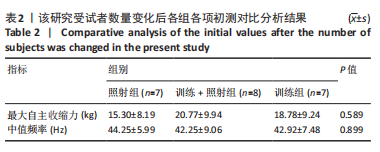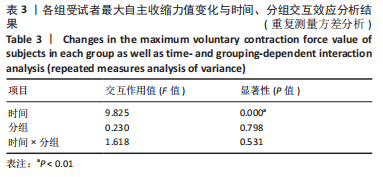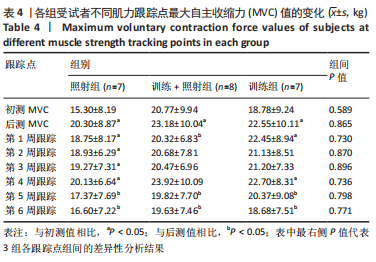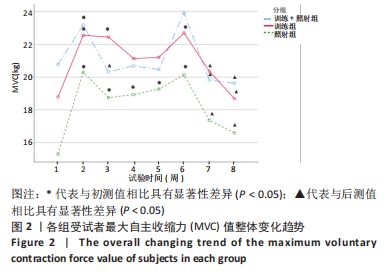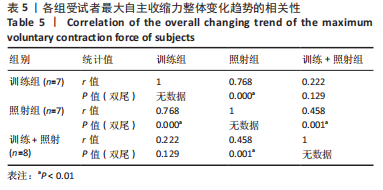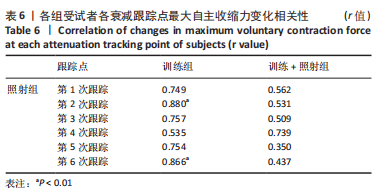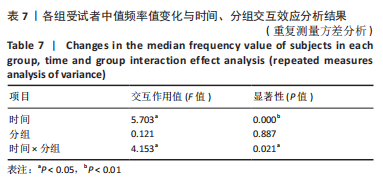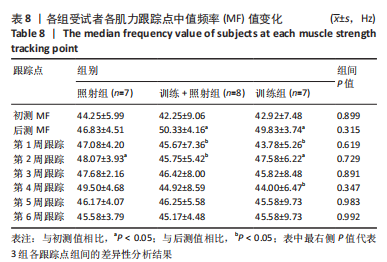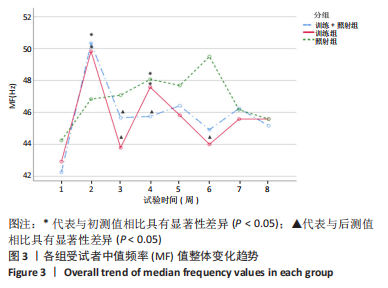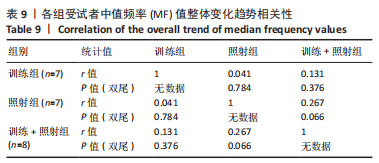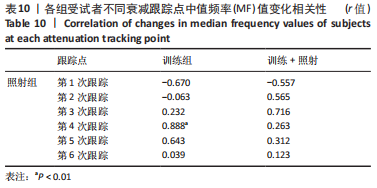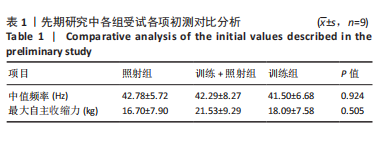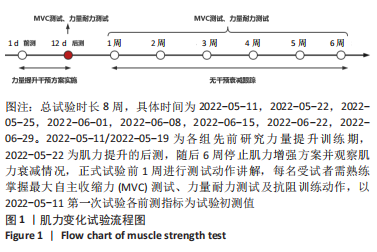中国组织工程研究 ›› 2023, Vol. 27 ›› Issue (23): 3721-3727.doi: 10.12307/2023.516
• 肌肉肌腱韧带组织构建 tissue construction of the muscle, tendon and ligament • 上一篇 下一篇
短期低频脉冲磁场诱导经典瞬时感受器电位通道1对局部肌肉肌力提升后的保持与衰减变化轨迹
厉中山1,2,白 石3,4,刘 洁5,杨铁黎6,邹宇琪3,孔维签3,李 伟3,张秦阳3,陈 松1,车同同7,李志远8,关荣鑫1,王春露9
- 1东北大学体育部,辽宁省沈阳市 110819;2福建师范大学体育科学学院,福建省福州市 350117;3沈阳工业大学信息科学与工程学院,辽宁省沈阳市 111003;4辽宁省磁医学检测与治疗专业技术创新中心,辽宁省沈阳市 110034;5中国医科大学科学实验研究中心,辽宁省沈阳市 110122;6首都体育学院,北京市 100191;7清华大学体育部,北京市100084;8浙江大学公共体育与艺术部,浙江省杭州市 310058;9北京体育大学冰上运动学院,北京市 100084
Maintenance and attenuation trajectory of increased muscle strength after exposure to short-term low-frequency pulsed magnetic field via activation of classical transient receptor potential vanilloid-1
Li Zhongshan1, 2, Bai Shi3, 4, Liu Jie5, Yang Tieli6, Zou Yuqi3, Kong Weiqian3, Li Wei3, Zhang Qinyang3, Chen Song1, Che Tongtong7, Li Zhiyuan8, Guan Rongxin1, Wang Chunlu9
- 1Department of Physical Education, Northeastern University, Shenyang 110819, Liaoning Province, China; 2School of Sports Science, Fujian Normal University, Fuzhou 350117, Fujian Province, China; 3School of Information Science and Engineering, Shenyang University of Technology, Shenyang 111003, Liaoning Province, China; 4Liaoning Provincial Technology Innovation Center for Magnetic Medicine Detection and Treatment, Shenyang 110034, Liaoning Province, China; 5Scientific Experiment Research Center of China Medical University, Shenyang 110122, Liaoning Province, China; 6Capital University of Physical Education and Sports, Beijing 100191, China; 7Department of Physical Education, Tsinghua University, Beijing 100084, China; 8Department of Public Sports and Arts, Zhejiang University, Hangzhou 310058, Zhejiang Province, China; 9School of Ice Sports, Beijing Sport University, Beijing 100084, China
摘要:
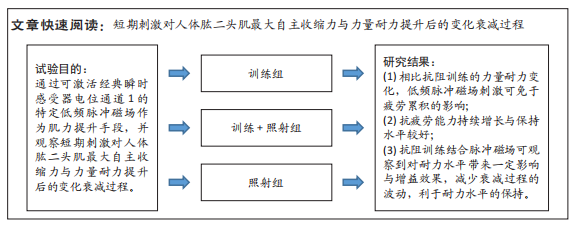
文题释义:
经典瞬时受体电位通道:是一类主要透Ca2+的非选择性阳离子通道,参与细胞内Ca2+的调节,在细胞的生理功能的调节中发挥了重要的作用。脉冲磁:该研究使用特殊构建的具有特定频率与强度的低强度脉冲磁场作为磁干预手段。
背景:短暂的低频脉冲磁场刺激可诱导和激活经典瞬时感受器电位通道1,并可提升人体局部肌肉(如肱二头肌)的最大自主收缩力与力量耐力。
目的:通过可激活经典瞬时感受器电位通道1的特定低频脉冲磁场作为肌力提升手段,并观察短期刺激对人体肱二头肌最大自主收缩力与力量耐力提升后的变化衰减过程。
方法:选取普通成年健康受试者27例,随机等分为训练组、照射组、训练+照射组。训练+照射组每次接受10 min低频脉冲磁场刺激后即刻进行抗阻训练,照射组只进行10 min低频脉冲磁场刺激,训练组采用抗阻训练,试验时间为8周,在正式试验的第1-12天进行短期肌力提升方案及力量水平后测,随后6周观察各组最大自主收缩力与力量耐力的衰减变化过程。
结果与结论:①所有被试者随着试验时间的不断推进,最大自主收缩力值变化显著(P < 0.01),时间交互效应明显,组间无交互效应,时间与分组交互效应不显著。②与初测值相比,照射组肌力衰减最大自主收缩力跟踪的第1,2,3,4周均显著高于初测值;训练组肌力衰减最大自主收缩力跟踪的第1,4周均显著高于初测值;与后测值相比,照射组最大自主收缩力值肌力衰减跟踪的第5,6周显著低于后测值;训练组最大自主收缩力肌力衰减跟踪的第5,6周显著低于后测值;训练+照射组肌力衰减最大自主收缩力跟踪的第1,5,6周显著低于后测值。③通过对3组最大自主收缩力变化曲线进行相关性分析可以看出,照射组整体最大自主收缩力肌力变化与训练组及训练+照射组最大自主收缩力变化趋势高度正相关,变化趋势高度一致。与照射组相比,训练组与训练+照射组最大自主收缩力具有更强的正相关性。④各组被试随着时间的推进,中值频率值均发生显著性变化(P < 0.01),时间交互效应明显,时间点和分组交互作用对中值频率值变化具有显著性影响(P < 0.05)。⑤与初测值相比,照射组肌力衰减中值频率值跟踪的第2周显著高于初测值;训练+照射组所有肌力衰减中值频率值跟踪的第2周显著高于初测值;与后测值相比,照射组肌力衰减中值频率值跟踪均与后测无显著性差异;训练组肌力衰减中值频率值跟踪的第1,4周显著低于后测值;训练+照射组肌力衰减中值频率值跟踪的第1,2周显著低于后测值。⑥3组受试者力量耐力中值频率值变化曲线进行相关性分析可以看出,照射组与训练组和训练+照射组之间具备较低的正相关性,与训练组相比,训练+照射组与照射组之间的相关程度略高。⑦结果显示,在强度1.5 mT、频率3 300 Hz的脉冲磁场短期刺激方案使肌力增强后,最大自主收缩力衰减到初测值的周期为6周,与该试验抗阻训练的衰减周期及提升后的衰减速度一致,在衰减过程中相比进行抗阻训练的2组变化波动较小,无疲劳累积的影响,肌力保持水平较佳。力量耐力提升后至少可保持6周。相比抗阻训练的力量耐力变化,低频脉冲磁场刺激可免于疲劳累积的影响,抗疲劳能力持续增长与保持水平较好,抗阻训练结合脉冲磁场可观察到对耐力水平带来一定影响与增益效果,减少衰减过程的波动,利于耐力水平的保持。
https://orcid.org/0000-0002-9010-609X(厉中山)
中国组织工程研究杂志出版内容重点:组织构建;骨细胞;软骨细胞;细胞培养;成纤维细胞;血管内皮细胞;骨质疏松;组织工程
中图分类号:
